AI has come so far so fast that we have barely had time to consider how to make it helpful. The human-centered artificial intelligence (AI) approach establishes values like security, ethics, user-focused design, and fairness to ensure that AI always serves our purposes.
These four values are reflected in the concerns of US adults in 2023, reporting that 74% are concerned that AI will negatively impact personal privacy and 70% are concerned that AI will lead to the spread of disinformation.
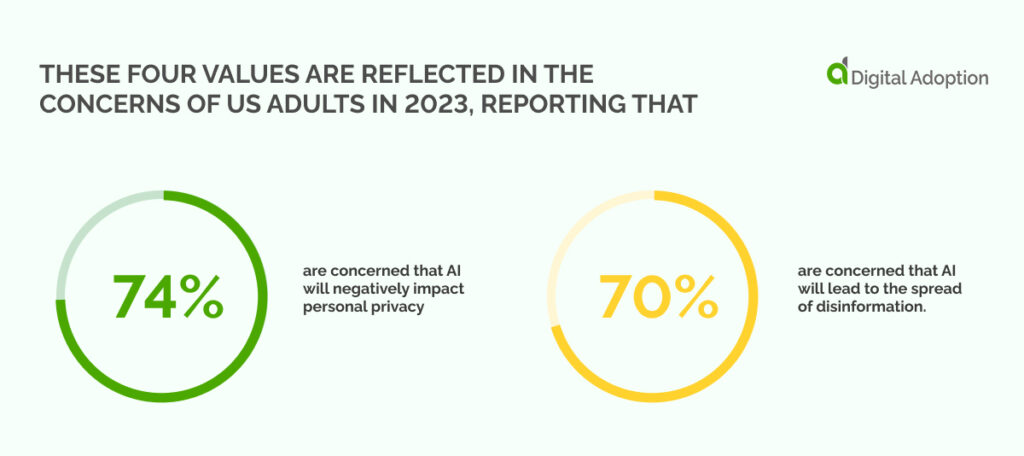
The human-centered approach tries to offset these concerns through user-focused AI digital adoption, implementation, and design, as well as streamlining AI risk management.
To help you understand what human-centric AI is and how to implement it, this article will explore the following topics:
- What is human-centered AI?
- Why is it important today?
- What are the human-centric AI values?
- What are the advantages and disadvantages?
- Industry-specific use cases for human-centric AI
- How to implement human-centered AI into your workflow
- What is human-centered AI?
- Why is human-centered AI important today?
- What are the human-centered AI values?
- What are the advantages of human-centric AI?
- What are the disadvantages of human-centric AI?
- Industry-specific use cases for human-centric AI
- How to implement human-centered AI into your workflow
- Adopt human-centered AI for outstanding employee experience
What is human-centered AI?
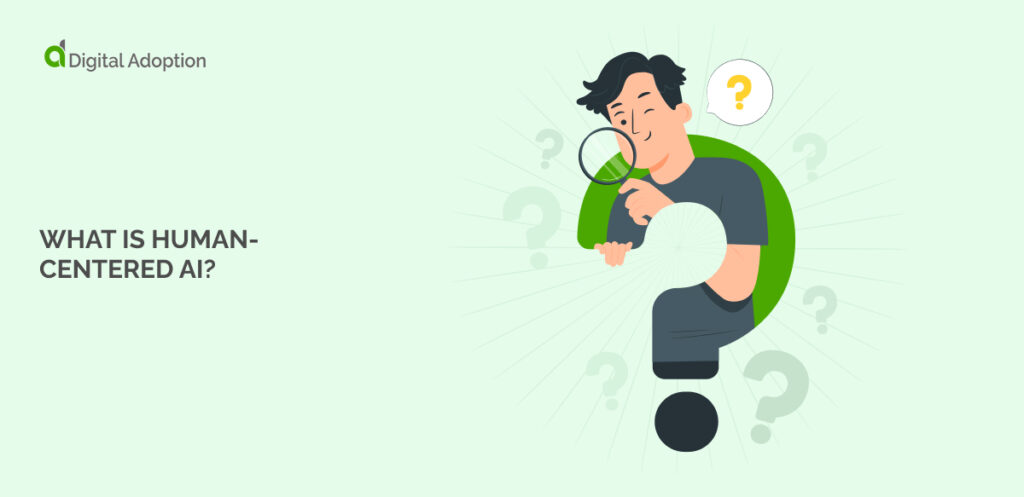
Human-centric AI prioritizes human values, needs, and well-being in the design and application of artificial intelligence. It emphasizes transparency, explainability, fairness, and privacy, ensuring AI tools are beneficial and trustworthy.
By focusing on user control, safety, and ethical considerations, human-centric AI seeks to avoid harmful consequences and biases. It champions accountability for AI actions and promotes inclusive design that respects diverse perspectives.
In short, human-centric AI ensures AI technologies serve as beneficial tools for individuals and societies rather than causing harm or unintended consequences.
Why is human-centered AI important today?
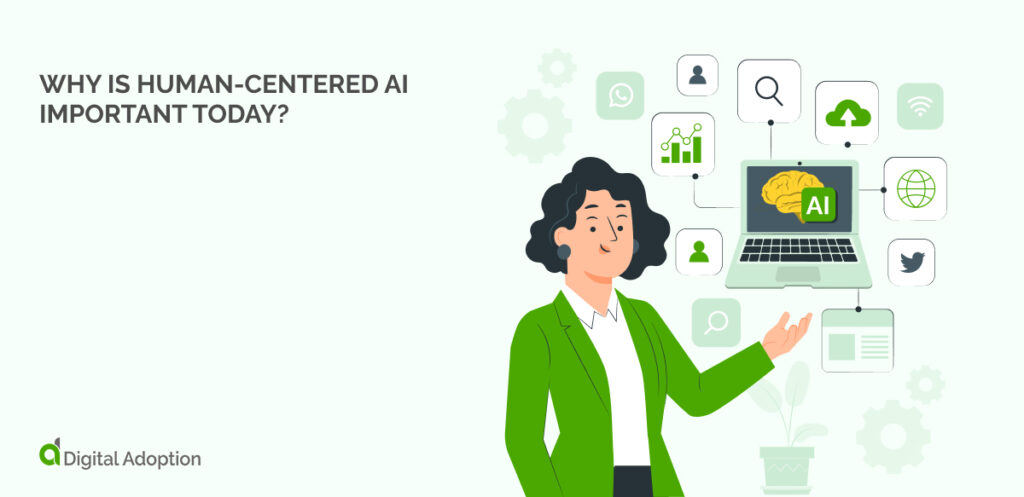
Human-centric AI becomes ever more critical as enterprises use generative AI tools like ChatGPT and Google Bard more.
To remain competitive, businesses must adopt AI, but they should also be mindful of its potential negative effects on their staff. The urgency to adopt AI is highlighted by projections indicating that the AI market value could reach $308 billion by 2026.
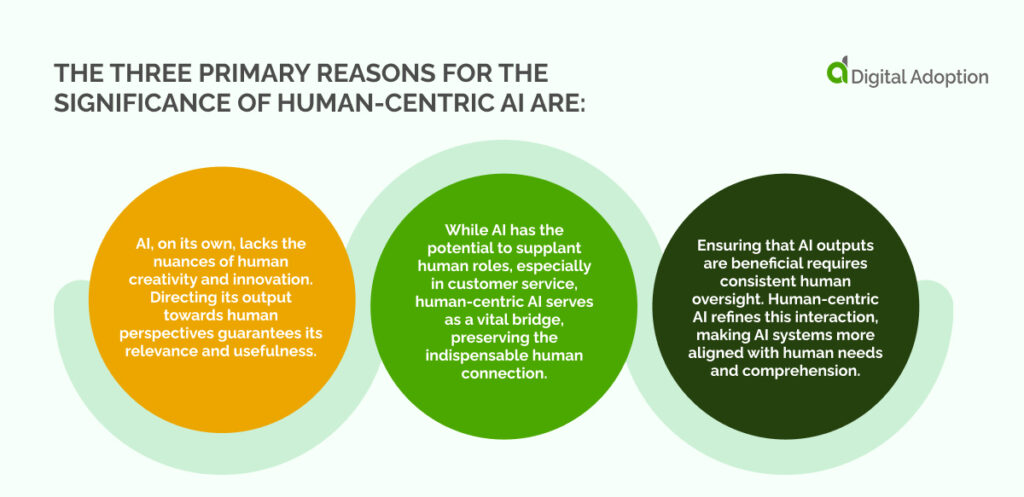
The three primary reasons for the significance of human-centric AI are:
- AI, on its own, lacks the nuances of human creativity and innovation. Directing its output towards human perspectives guarantees its relevance and usefulness.
- While AI has the potential to supplant human roles, especially in customer service, human-centric AI serves as a vital bridge, preserving the indispensable human connection.
- Ensuring that AI outputs are beneficial requires consistent human oversight. Human-centric AI refines this interaction, making AI systems more aligned with human needs and comprehension.
What are the human-centered AI values?
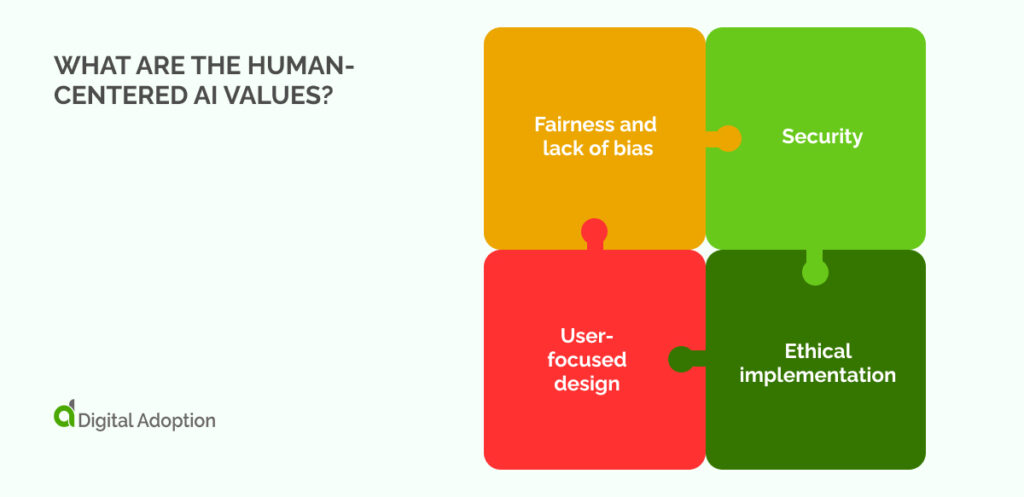
Phrases like ‘human-centric AI’ can sound can sound idealistic and may be difficult to realize without clearly defining the underlying values.
Consider the values below to understand human-centric AI.
Fairness and lack of bias
AI system biases can stem from various sources, including skewed training data, flawed algorithms, and unconscious human biases. These biases may yield discriminatory or unjust outcomes, harming users and undermining trust in AI solutions.
AI systems like ChatGPT may manifest inaccurate information due to demographic, confirmation, and sampling biases.
Security
Inputting sensitive third-party or internal company information into ChatGPT integrates it into the chatbot’s data model, exposing it to others with relevant queries.
Doing so poses the risk of data leakage and could violate an organization’s data retention policies.
Ethical implementation
The rapid progress and incorporation of generative AI have prompted numerous ethical concerns regarding the new and extensive human-computer interaction, use, and continuous expansion.
Ethical AI implementation tries to regain human control of digital AI tools by implementing AI by tackling the following issues by prioritizing human values:
- Job displacement.
- Inquiries about research bias.
- Worries about consumer data privacy.
- Consent for data usage in language learning tools.
Reflect on these ethical considerations to ensure the responsible utilization of generative AI tools.
User-focused design
Building AI with the user in mind is crucial for meaningful and seamless integration into daily life.
User-centric design ensures that AI aligns with human needs, preferences, and behaviors, fostering user acceptance and engagement.
This approach not only enhances user experience but also maximizes the positive impact of AI on individuals and society as it produces human-centered outcomes by making it easy to create human-centric inputs.
What are the advantages of human-centric AI?
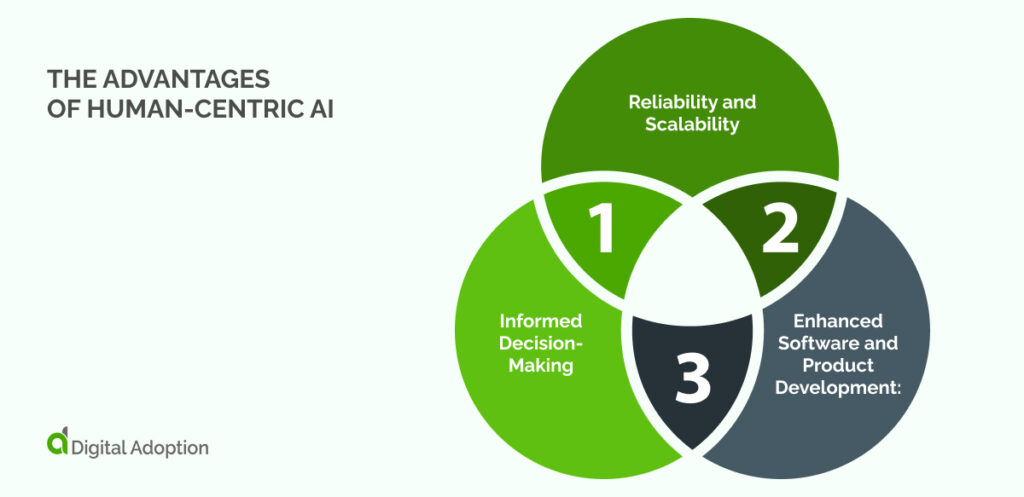
There are many business benefits to using human-centric AI, as well as it being better for the wellbeing of your staff in the short and long term.
Informed Decision-Making
Human-centered AI aims not to replace humans but to augment our capabilities through intelligent, human-informed technology using adaptive AI.
Combining NLP machine learning precision with human input and values empowers businesses (specifically, their human assets) to make informed decisions and devise clearer strategies to address challenges.
Reliability and Scalability
Human-centered AI harnesses human thinking abilities, enabling ideas to scale for more extensive data requirements and avoid data silos.
While AI serves to assist humans, its effectiveness suffers limits without human input and comprehension.
A human-centric AI approach shares the computational load with technology, utilizing emotional and cognitive input from humans.
This approach facilitates expanding processes and information on a larger scale without compromising data integrity or escalating human resource expenses.
Enhanced Software and Product Development:
Applying behavioral science principles to technology through human-centered AI allows developers and designers to delve into user behavior and subconscious patterns.
This action results in creating products and services offering more satisfying, informed, enriching, and, in the case of platforms like Instagram or games, addictively rewarding user experiences.
What are the disadvantages of human-centric AI?
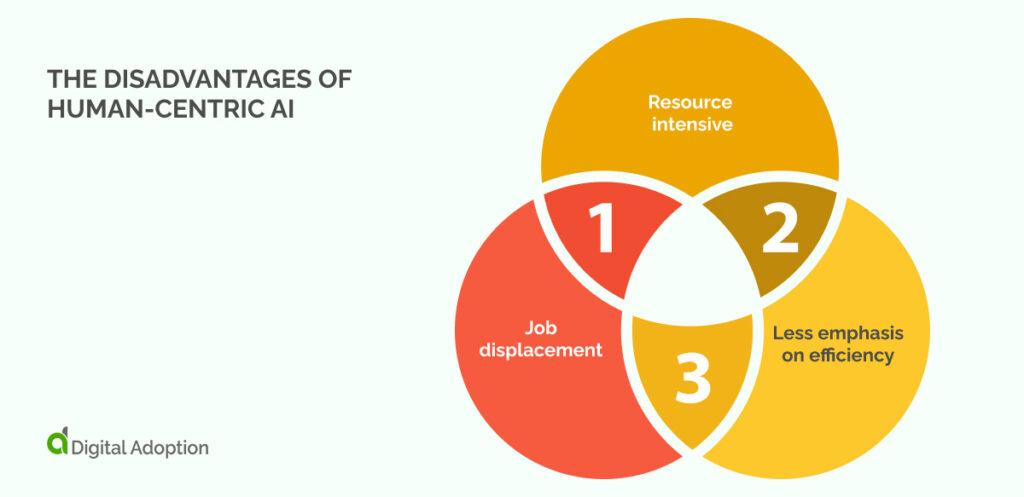
Despite its advantages, human-centric AI still carries some disadvantages that affect all forms of AI.
Job displacement
Despite its best attempts, any form of AI, even AI with a human-centric approach, can lead to job losses as this technology can make some roles obsolete.
Resource intensive
Much like psychology-focused change management models, human-centric AI can involve more time and effort while staff receive training on correctly using it.
Less emphasis on efficiency
Because human-centric AI focuses on user design and ethics, it does not exist to maximize profits or efficiency.
Other forms of AI may extract higher revenue, though they may lead to burnout.
Industry-specific use cases for human-centric AI
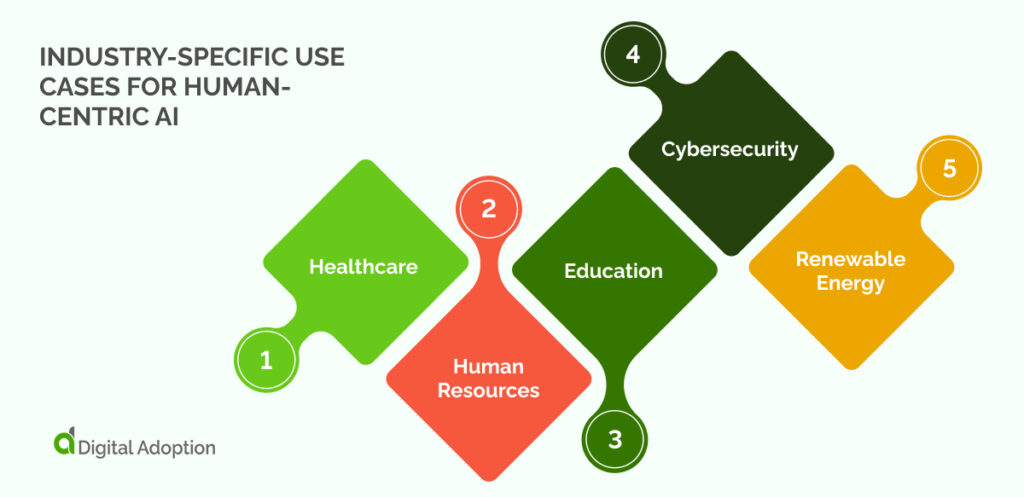
Understanding human-centric AI is much easier when you see it utilized in use cases.
See the examples below to strengthen your understanding of these types of AI that can teach you that using tools that utilize machine learning doesn’t mean your employees have to behave like machines.
1. Healthcare
Human-Centered AI enhances efficiency in the healthcare sector for patients, doctors, and professionals.
The algorithm analyzes diverse healthcare data, organizing it to reveal insights, patterns, and new drug applications, as demonstrated in developing a COVID-19 treatment.
It organizes clinical trials, medical claims, and images effectively.
2. Human Resources
Organizations facing bias allegations in hiring can adopt Human-Centered AI to eliminate biases. Utilizing job-related data in applications ensures hiring decisions prioritize diversity, fostering an inclusive hiring process.
3. Education
AI significantly influences teaching and online education and optimizes the utilization of data science.
Human-centered AI aids educators in course creation, student assessment, time-saving, and task automation, catering to individual student needs.
4. Cybersecurity
Basic AI detects network intrusion, fraud, hacks, user authentication, and spam.
Human-centered AI systems anticipate attacks, fortifying security preemptively.
5. Renewable Energy
Human-centered AI is essential for harnessing renewable energy. It manages decentralized grids, balances, stores, and optimizes real-time electricity demands and supply.
Gas turbines with attached sensors linked to AI systems adjust fuel valves, ensuring low emissions and informed decisions to reduce environmental impact.
How to implement human-centered AI into your workflow
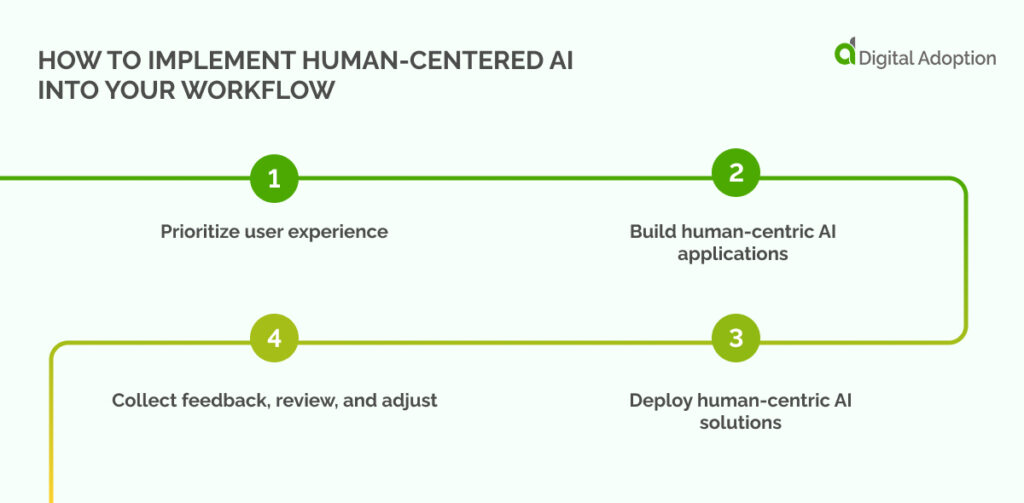
Follow these steps to implement human-centric AI into your organization’s workflows.
1. Prioritize user experience
Begin with research to grasp the user experience and pertinent data for interactions. Utilize methods like surveys, focus groups, and customer interviews. Apply these insights to craft AI applications.
2. Build human-centric AI applications
Develop solutions aiding users in task completion. These solutions are versatile, fitting into various platforms like apps, websites, ads, or mobile devices.
3. Deploy human-centric AI solutions
Extend these solutions across multiple touchpoints, ensuring easy user interaction for task assistance or information-seeking related to desired products/services.
4. Collect feedback, review, and adjust
Assess solution effectiveness by constructing a prototype. Monitor user interactions, purposes, and satisfaction levels to gauge the quality of their overall experience.
Adopt human-centered AI for outstanding employee experience
Embracing a Human-centered AI approach transforms the employee experience, fostering a workplace where technology aligns seamlessly with human needs.
By prioritizing user-centric design with a human-centered approach, AI applications enhance task efficiency, decision-making, and digital employee experience.
This approach ensures that technology becomes a supportive ally, minimizing biases in hiring processes and promoting a diverse and inclusive work environment.
Adopting Human-Centric AI and the neural networks they utilize alongside human expertise enriches the overall employee experience, driving productivity and well-being.

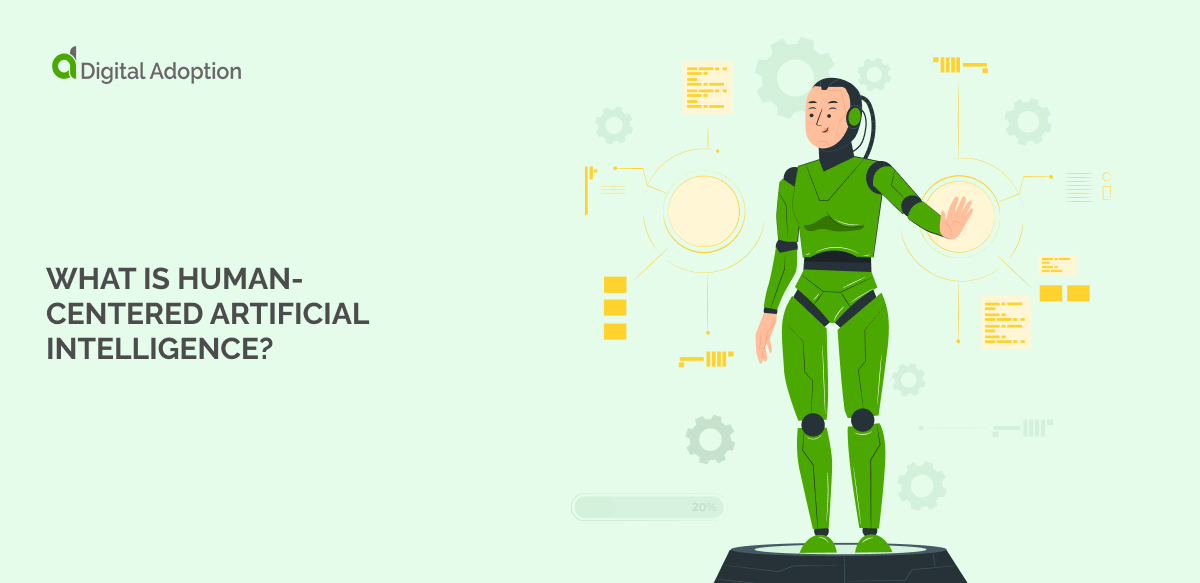


![18 Examples of AI in Finance [2025]](https://www.digital-adoption.com/wp-content/uploads/2025/06/18-Examples-of-AI-in-Finance-2025-300x146.jpg)
![14 Examples of AI in Manufacturing [2025]](https://www.digital-adoption.com/wp-content/uploads/2025/06/14-Examples-of-AI-in-Manufacturing-2025-300x146.jpg)
![29 Examples of AI in Education [2025]](https://www.digital-adoption.com/wp-content/uploads/2025/06/29-Examples-of-AI-in-Education-2025-300x146.jpg)
![15 Examples of AI in Retail [2025]](https://www.digital-adoption.com/wp-content/uploads/2025/06/15-Examples-of-AI-in-Retail-2025-300x146.jpg)
![13 Examples of AI in Healthcare [2025]](https://www.digital-adoption.com/wp-content/uploads/2025/06/AI-in-healthcare-examples-300x146.jpg)


![18 Examples of AI in Finance [2025]](https://www.digital-adoption.com/wp-content/uploads/2025/06/18-Examples-of-AI-in-Finance-2025.jpg)
![14 Examples of AI in Manufacturing [2025]](https://www.digital-adoption.com/wp-content/uploads/2025/06/14-Examples-of-AI-in-Manufacturing-2025.jpg)
![29 Examples of AI in Education [2025]](https://www.digital-adoption.com/wp-content/uploads/2025/06/29-Examples-of-AI-in-Education-2025.jpg)